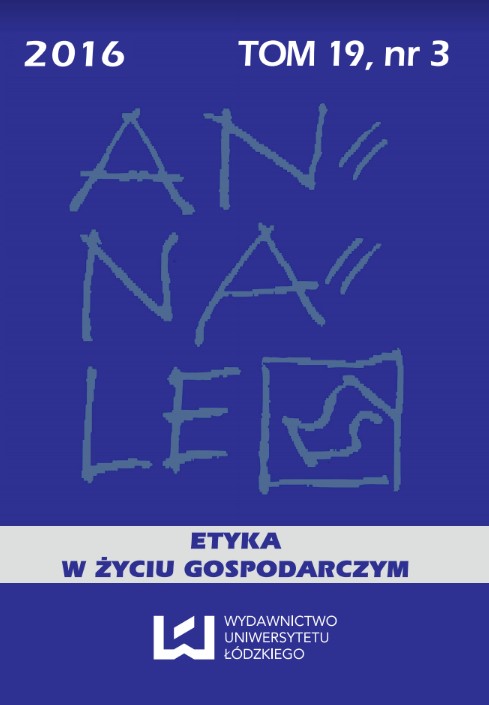Kontrowersje związane z reklamowaniem leków. Analiza porównawcza Polski i Stanów Zjednoczonych
DOI:
https://doi.org/10.18778/1899-2226.19.3.13Słowa kluczowe:
pharmaceutical industry, advertisement, drugs, law, ethicsAbstrakt
For many years, the subject of aggressive marketing campaigns conducted by pharmaceutical companies has been raised in Poland. Drug ads are everywhere, on television, the radio, magazines and on the Internet. Therefore, it is extremely important is to ensure both their legal and ethical dimension. In my article I will present the differences between direct-to-consumer advertising of medicines in Poland and in the US. The dissimilarities result mainly from differences in legislation. In Poland the law is much stricter than in the US. For example, in the United States companies are allowed to advertise prescription drugs directly to patients. In the whole of the European Union, and thus in Poland, it is strictly prohibited. The article will present other regulations existing in Poland and in the United States and it will compare them. It will show examples of violations of the law and ethics in the advertising of medicine in both countries. It will briefly outline the negative consequences of unacceptable pharmaceutical marketing.Bibliografia
Arnold D., J. Oakley, The Politics and Strategy of Industry Self-Regulation: The Pharmaceutical Industry's Principles for Ethical Direct-to-Consumer Advertising as a Deceptive Blocking Strategy, „Journal of Health Politics, Policy and Law” 2013, vol. 38, nr 3, s. 505–544.
Google Scholar
DOI: https://doi.org/10.1215/03616878-2079496
ASRC, NARB Panel Recommends Novartis Discontinue Claims that Excedrin Starts Relieving Headache Pain Faster than Advil Claims at Issue Challenged by Pfizer Consumer Healthcare, 2012, http://www.asrcreviews.org/2012/01/narb-panel-recommends-novartis-discontinue-claims-that-excedrin-starts-relieving-headache-pain-faster-thanadvil-claims-at-issue-challenged-by-pfizer-consumer-healthcare/
Google Scholar
Blinkoff, S., K. Tabela, USA – Pharmaceutical Advertising 2015. International Comparative Legal Guides, 2015, http://www.iclg.co.uk/practice-areas/pharmaceutical-advertising/pharmaceutical-advertising-2015/usa
Google Scholar
Chaniecka K.A., A. Czerw, Płeć a postrzeganie reklamy telewizyjnej leków OTC, „Hygeia Public Health” 2013, nr 48, s. 509–514.
Google Scholar
CHPA, OTC Drug Advertising, 2015 http://www.chpa.org/OTCDrugAdvertising.aspx
Google Scholar
Diehl S, B. Mueller, R. Terlutter, Consumer Responses Towards Non-Prescription and Prescription Drug Advertising in the US and Germany: They Don’t Really Like It, but They Do Believe It, „International Journal of Advertising” 2008, nr 27(1), s. 99–131.
Google Scholar
DOI: https://doi.org/10.1080/02650487.2008.11073042
Donohue J., A History of Drug Advertising: The Evolving Roles of Consumers and Consumer Protection, „The Milbank Quarterly” 2006, nr 84, s. 659–699.
Google Scholar
DOI: https://doi.org/10.1111/j.1468-0009.2006.00464.x
Dz.U. 1991 nr 105 poz. 452, Ustawa o środkach farmaceutycznych, materiałach medycznych, aptekach, hurtowniach i nadzorze farmaceutycznym.
Google Scholar
Dz.U. 1993 nr 47 poz. 211, Ustawa o zwalczaniu nieuczciwej konkurencji.
Google Scholar
Dz.U. 2008 nr 45 poz. 271, Prawo Farmaceutyczne.
Google Scholar
Faerber A.E., D.H. Kreling, Content Analysis of False and Misleading Claims in Television Advertising for Prescription and Nonprescription Drugs, „Journal of General Internal Medicine” 2012, nr 29, s. 110–118.
Google Scholar
DOI: https://doi.org/10.1007/s11606-013-2604-0
FDA, Cipher Pharmaceuticals Inc. Warning Letter, 2014, http://www.fda.gov/downloads/Drugs/GuidanceComplianceRegulatoryInformation/EnforcementActivitiesbyFDA/WarningLettersandNoticeofViolationLetterstoPharmaceuticalCompanies/ UCM415228.pdf
Google Scholar
FDA, Drug Applications for Over-the-Counter (OTC) Drugs, 2015, http://www.fda.gov/drugs/developmentapprovalprocess/howdrugsaredevelopedandapproved/approvalapplications/over-the-counterdrugs/default.htm
Google Scholar
FDA, Inspections, Compliance, Enforcement, and Criminal Investigations, Warrning Letters, Drugs, 2015, http://www.fda.gov/Drugs/GuidanceComplianceRegulatoryInformation/EnforcementActivitiesbyFDA/WarningLettersandNoticeofViolationLetterstoPharmaceuticalCompanies/default.htm
Google Scholar
FDA, Prescription Drug Advertising, http://www.fda.gov/Drugs/ResourcesForYou/Consumers/PrescriptionDrugAdvertising/default.htm
Google Scholar
Główny Inspektorat Farmaceutyczny, Decyzje i komunikaty, https://www.gif.gov.pl/pl/decyzje-i-komunikaty/decyzje/decyzje
Google Scholar
Główny Inspektorat Farmaceutyczny, Decyzja z dnia 31.01.2011, znak: GIF-P-R-450/106- 4/JD/10/11, 2011, https://www.gif.gov.pl/pl/decyzje-i-komunikaty/decyzje/archiwum/wstrzymanie-reklam/80,Rok-2011.html
Google Scholar
Główny Inspektorat Farmaceutyczny, Decyzja z dnia 26.04.2012, znak: GIF-P-R-450/14-2/JD/ 12,2012, https://www.gif.gov.pl/pl/decyzje-i-komunikaty/decyzje/archiwum/wstrzymanie-reklam/79,Rok-2012.html
Google Scholar
Główny Inspektorat Farmaceutyczny, Decyzja z dnia 11.09.2014, znak: GIF-P-R-450/46-2/JD/ 14, 2014, https://www.gif.gov.pl/pl/decyzje-i-komunikaty/decyzje/decyzje/619,Decyzja-z-dnia-11092014-znak-GIF-P-R-45046-2JD14.html
Google Scholar
Frosch D., P.M. Kruger, R.C. Hornik, P. Cronholm, F. Barg, Creating Demand for Prescription Drugs: A Content Analysis of Television Direct-to-Consumer Advertising, „Annals of Family Medicine” 2007, nr 1(5), s. 6–13.
Google Scholar
DOI: https://doi.org/10.1370/afm.611
KPMG i IAA, Rynek reklamy telewizyjnej w Polsce po latach wychodzi na prostą, Warszawa 2015.
Google Scholar
Kravitz R.L., Direct-to-Consumer Advertising of Prescription Drugs, „The Western Journal of Medicine” 2000, nr 173(4), s. 221–222.
Google Scholar
DOI: https://doi.org/10.1136/ewjm.173.4.221
Kula P., Pharmaexpert podsumowuje rynek apteczny w 2014 roku, 2015, http://www.aptekarzpolski.pl/index.php?option=com_content&task=view&id=1850&Itemid=79
Google Scholar
Mack J., Increased DTC Advertising and Rising Drug Prices – Is There a Causal Link?, 2015, http://pharmamkting.blogspot.com/2015/11/increased-dtc-advertising-and-rising.html
Google Scholar
Makowska M., Etyczne standardy marketingu farmaceutycznego, CeDeWu, Warszawa 2010.
Google Scholar
Makowska M., Etyczne wyzwania współpracy studentów medycyny z przemysłem farmaceutycznym. Studium porównawcze sytuacji w USA i Polsce, Wydawnictwo SGGW, Warszawa 2016.
Google Scholar
Marketing przy kawie, Koncerny farmaceutyczne mocno inwestują w reklamę. Aflofarm na czele peletonu, 2014, http://www.marketing-news.pl/theme.php?art=1804
Google Scholar
Michalski B., Ł. Sławatyniec, M. Duczyńska, K. Kęska, Prawo farmaceutyczne i refundacja leków, Walters Kluwer, Warszawa 2013.
Google Scholar
Mogull, S.A., Chronology of Direct-to-Customer Advertising Regulation in the United States, „American Medical Writers Association Journal” 2008, nr 23(3), s. 106–109.
Google Scholar
PAIiIZ, Sektor faramaceutyczny i biotechnologiczny w Polsce, Polska Agencja Informacji i Inwestycji Zagranicznych SA, Warszawa 2013.
Google Scholar
Rada Reklamy, Komisja Etyki Reklamy, https://www.radareklamy.pl/komisja-etyki-reklamy
Google Scholar
Rada Reklamy, Uchwała Nr ZO 40/11 w sprawie reklamy firmy Novartis Poland Sp. z o.o., 2011, https://www.radareklamy.pl/uchwaly-ker/2011/uchwa%C5%82a-nr-zo-40-11-w-sprawie-reklamy-firmy-novartis-poland-sp-z-o-o
Google Scholar
Rada Reklamy, Uchwała Nr ZO 64/14 w sprawie reklamy firmy Pfizer Trading Polska Sp. z o.o., 2014, https://www.radareklamy.pl/uchwaly-ker/2014/uchwa%C5%82a-nr-zo-64-14-w-sprawie-reklamy-firmy-pfizer-trading-polska-sp-z-o-o
Google Scholar
Stange K.C., Time to Ban Direct-to-Consumer Prescription Drug Marketing, „Annals of Family Medicine” 2007, nr 5(2), s. 101–104.
Google Scholar
DOI: https://doi.org/10.1370/afm.693
Szuba T., Ekonomka leku. Podręcznik dla studentów farmacji i farmaceutów, „Aptekarz” 2003, vol. 11, nr 10, s. 257–292.
Google Scholar
Szuba T., Polityka leku w Polsce. „Aptekarz” 1994, vol. 2, nr 9, s. 379–386.
Google Scholar
Sudak I., My, Polacy, lekomani. Rekordowe wydatki na leki, groźne skutki reklam, „Gazeta Wyborcza” 2015, http://wyborcza.biz/biznes/1,100896,17513743,My__Polacy__lekomani__Rekordowe_wydatki_na_leki__grozne.html#ixzz3uwzWsiDa
Google Scholar
Ventola C., Direct-to-Consumer Pharmaceutical Advertising. Therapeutic or Toxic?, „Pharmacy and Therapeutics” 2011, nr 10(36), s. 669–684.
Google Scholar
Zarzeczna-Baran M., E. Bandurska, J. Pęgiel-Kamrat, A. Lewandowska, Wpływ reklamy na zakup leków dostępnych bez recepty, „Annales Academiae Medicae Gedanensis”, 2013, nr 43, s. 77–87.
Google Scholar
Pobrania
Opublikowane
Jak cytować
Numer
Dział
Licencja

Utwór dostępny jest na licencji Creative Commons Uznanie autorstwa – Użycie niekomercyjne – Bez utworów zależnych 4.0 Międzynarodowe.









